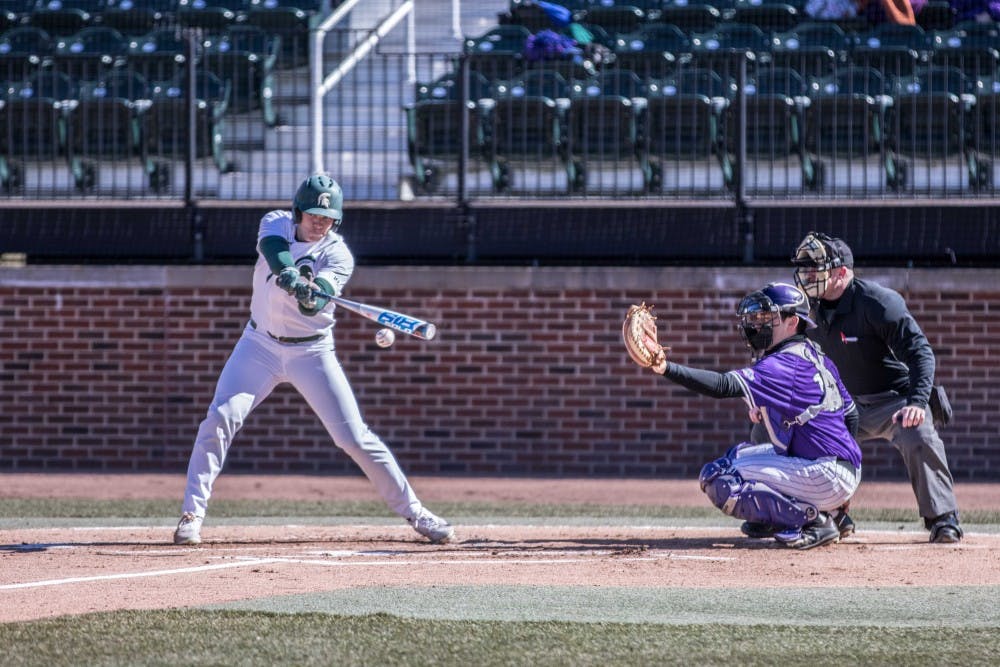Whether it be hitting a 90 mph fastball or throwing an 87 mph curveball to get the batter swinging, baseball is likely known as one of the hardest sports to master for same people.
Most recently, Shohei Ohtani of the Los Angeles Angels made headlines coming from Japan as a two-way player.
A two-way player is one who is capable of both pitching and batting.
The MSU baseball team currently has a pair of two-way players on its roster: sophomore outfielder and left-handed pitcher Bryce Kelley and freshman infielder and right-handed pitcher Zach Iverson.
“Some days, like in the fall, I would do all the infield work and then I would have to go to the mound and throw a bullpen and it would be a lot,” Iverson said. “With our trainers’ help, I’ve been able to stay healthy.
“I’ve been able to continue to do that, continuously throughout the fall and throughout now and it’s been good.”
Iverson has shown strides of potential, as he has a .269 batting average with 14 hits on the season.
Iverson has also already hit the mound twice this season, once against Illinois and once against Central Michigan University.
He said being a two-way player is valuable, since the team is getting “two guys on (its) roster, but only filling out one spot.”
“You get an extra pitcher in there, and pitchers are so important through the season. Always having that extra hitter, you know, big game, eighth inning, you need someone to fill that spot and you have another guy to be able to just throw in there,” Iverson said. “It’s good to have a guy that can play both and that can do both.”
Kelley has the skill to be at the mound, however, the Spartans favor him more as a hitter, as he has a .353 batting average with 55 hits in his freshman season.
He has gotten at least one hit in 26 of the last 27 games.
Kelley has yet to pitch a game for the Spartans in his young collegiate career.
The Rockford, Michigan native said when he came to East Lansing, he was not sure whether he would be an outfielder or a pitcher.
“It was a tossup from the start,” Kelley said. “Coming in here and that the end of my first freshman fall I thought that spring I’d have better shot at pitching than anything, and it turns out to be the exact opposite.”
Kelley said he’s been playing outfield for two years now with no pitching yet, but still is considered a pitcher which is a fun challenge every day.
Head coach Jake Boss Jr. said Iverson and Kelley are both athletic players who had a lot of success in high school.
But the tricky thing, he said, is managing their throwing arms and making sure they don’t get to0 much throwing from their position play one day or on the mound the next day.
“It can be used as a very good thing, I’d say,” Kelley said. “Makes you very well-rounded, you respect your position of each position that you play and you respect the guys that you play with. It’s definitely a challenge.”
Iverson started out as a position player and developed as a pitcher with no real pitching coach — so he taught himself.
Support student media!
Please consider donating to The State News and help fund the future of journalism.
“The one I probably like the most is hitting,” Iverson said. “There’s nothing better than hitting the ball hard, I guess, or fielding a ball and throwing the guy out, making a big play. But pitching’s also good, too. They’re both good to me, it’s hard to pick one.”
The Big Ten has a total of 12 two-way players with Iowa having the most at three.
MSU is tied with the second most with University of Michigan, with Maryland, Illinois, Rutgers, Minnesota and Nebraska each having a two-way player each.
“Being an everyday player in the outfield is very fun, and being a pitcher is a little bit different because you have the ball and everyone is kind of looking at you,” Kelley said. “Depending on the day, if my stuff’s there, pitching is really fun, but I love hitting.”
Discussion
Share and discuss “Two-way players bring value and flexibility to baseball” on social media.





